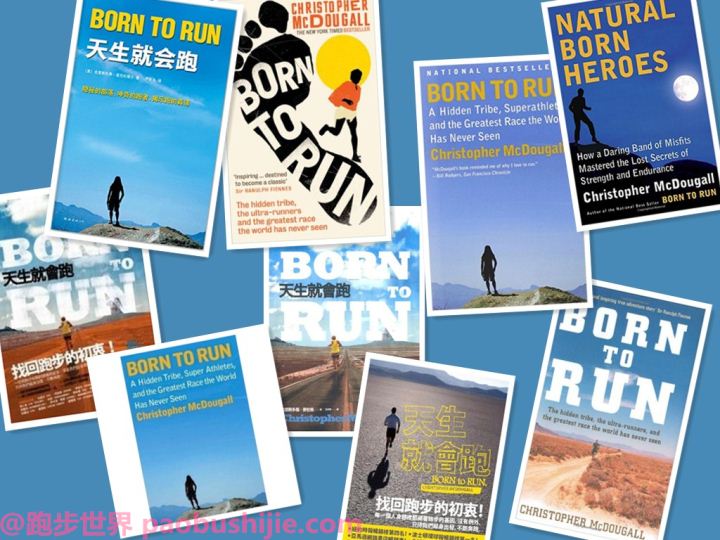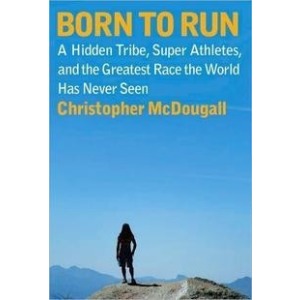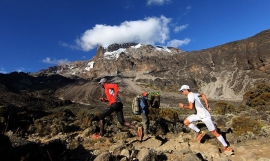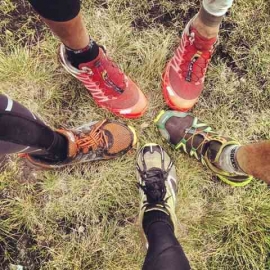
Born to Run(天生就会跑)合集:
Born to Run(天生就会跑)英国版:
Born to Run: The Rise of Ultra-running and the Super-athlete Tribe(英国第1版)_Christopher McDougall_2009
Born to Run(天生就会跑)繁体中文版:
天生就会跑(Born to Run 繁体中文第1版)_Christopher McDougall著;王亦穹译_2010
天生就会跑(Born to Run 繁体中文第2版)_Christopher McDougall著;王亦穹译_2013
Born to Run(天生就会跑)简体中文版:
天生就会跑(Born to Run 简体中文版)_克里斯托弗•麦克杜格尔 (Christopher McDougall)、严冬冬译_2012
Born to Run: A Hidden Tribe, Superathletes, and the Greatest Race the World Has Never Seen Reviews
Born to Run succeeds at three levels. First, it is a page turner. The build up to a fifty-mile foot race over some of the world's least hospitable terrain drives the narrative forward. Along the way McDougall introduces a cast of characters worthy of Dickens, including an almost superhuman ultramarathoner, Jenn and the Bonehead--a couple who down bottles of booze to warm up for a race, Barefoot Ted, Mexican drug dealers, a ghostly ex-boxer, a heartbroken father, and of course the Tarahumara, arguably the greatest runners in the world.
Born to Run is such a rip-roaring yarn, that it is easy to miss the book's deeper achievements. At a second level, McDougall introduces and explores a powerful thesis--that human beings are literally born to run. Recreational running did not begin with the 1966 publication of "Jogging" by the co-founder of Nike. Instead, McDougall argues, running is at the heart of what it means to be human. In the course of elaborating his thesis, McDougall answers some big questions: Why did our ancestors outlive the stronger, smarter Neanderthals? Why do expensive running shoes increase the odds of injury? The author's modesty keeps him from trumpeting the novelty and importance of this thesis, but it merits attention.
Finally, Born to Run presents a philosophy of exercise. The ethos that pervades recreational and competitive running--"no pain, no gain," is fundamentally flawed, McDougall argues. The essence of running should not be grim determination, but sheer joy. Many of the conventions of modern running--the thick-soled shoes, mechanical treadmills, take no prisoners competition, and heads-down powering through pain dull our appreciation of what running can be--a sociable activity, more game than chore, that can lead to adventure.
"Born to Run" is a revolutionary book containing an invaluable message that could change the way you think about running forever. Unfortunately, this message is buried within 282 pages of rambling narrative filled with improbable characters and punctuated with hyperbole on nearly every page.
By the time I had reached chapter 8, I had tired of the narrative and was wishing the author would simply get to the point. Where was the great stuff about "the joy of running" that other reviewers had said they'd found in this book? Where was that eye-opening screed against Nike as the company that had single-handedly destroyed running for an entire generation of runners? So I did a little digging, and I found the two chapters that addressed these topics. They were terrific! I found a couple other good ones too, that had little or nothing to do with the narrative. Then I basically skipped the remainder of the book.
As far as I'm concerned, the "must-read" chapters in this book are chapters 15, 25, 27 and 28.
Chapter 15 speaks about running for the pure joy of it. The Tarahumara Indians of Mexico who make up the main characters of this book evidently are a tribe who never forgot what a joy it is simply to run! This chapter talks about where running goes wrong for most of us - how it is that something so joyful can so easily devolve into a chore or a contest, and also how it is that America lost its dominance in distance running as soon as money entered the equation. The chapter equates love of running with love of life. It is an inspiring and thought provoking read.
Chapter 25 describes the devastating effect that Nike's invention of the running shoe has had on the sport of running, dramatically escalating the rates of injury that people suffer from running. This astonishing chapter, to me, would be enough to make buying the whole book worthwhile. The chapter cites several studies that have shown that the more expensive a running shoe you buy, the MORE likely you are to suffer running injuries! The heavily-padded and rigidly constructed cocoons that pass for modern running shoes have robbed the foot of the ability to do the things it was designed to do for the runner. As a result the foot becomes weak and out of shape, and injuries result. The heavily padded heel also has changed the stride of the modern runner to a long, heel-striking stride that is destructive to the joints no matter how heavily padded the shoe. Prior to this invention, runners ran on the outsides and balls of their feet, and injuries were substantially lower. Nike itself seems to have finally caught on to this by designing a new kind of running shoe (called the "Free") with minimal padding and support.
Unfortunately, most of the medical establishment has evidently not yet caught up to these truths, according to the author. He cited expert after expert who all sang the same tune that "running is hard on the feet and joints" and "our bodies were not made for running." They generally counseled buying expensive running shoes or even more costly orthotics, or else giving up running as a sport altogether. Thankfully, there are also a few more enlightened medical experts out there, also cited in the book, who paint an entirely different story. The human foot is a marvel of engineering. It is only our tinkering with its environment (by encasing it in supports it doesn't need) that have made it seem so ill suited for what it was made to do.
Chapter 27 details how the author, a tall and heavy-boned man who had perpetually been plagued with joint problems and injuries when trying to run even short distances, was finally able to overcome these difficulties and become a distance runner by completely reworking his stride. This chapter includes a useful mention of three very similar running styles that all have books out detailing them, called Evolution Running, Chi Running, and the POSE method. These methods all stress getting rid of our overpadded running shoes and running more on the balls of the feet rather than landing on the heels, with short quick strides, keeping your weight centered above your feet. There is enough information in this chapter to help someone experiment with these methods, but from what I've read elsewhere it takes time and practice to master any one of them, and the reader would be best advised to refer to one of the books or videos available through Amazon that teach these techniques if the desire is to master this type of running style. Chapter 27 also talks about how the author switched to a much healthier, mostly vegan diet, and the positive effects that came from doing this.
Chapter 28 is an overly-long but nevertheless interesting development of a theory that humans evolved to be long-distance running machines. The author spends a good bit of time quoting various experts and presenting evidence to support this theory. While humans are nowhere near the fastest land animals in a short race, we exceed all other species in our ability to run long distances. The theory is that this would allow a hunter on foot to catch speedier prey simply by chasing them over long distances until they fall exhausted. The title of the book, "Born to Run", comes out of this chapter, making the case that we should all be runners because, after all, we are built to do exactly that.
I would advise busy readers to either buy this book used or else check it out of the library, and start by reading perhaps the first few chapters just to get the background of the narrative that winds its way through the book. If you find that the narrative appeals to you then you will probably want to just read the whole thing cover to cover. If, like me, you find the narrative to be not worth the time, then skip to chapters 15, 25, 27 and 28. These chapters are definitely worth the reading, and may change the way you think about running as a sport for yourself, especially if injuries have hindered you from running in the past.
I will let the final words of Chapter 28 sum up the value of this book: "So simple... Just move your legs. Because if you don't think you were born to run, you're not only denying history. You're denying who you are." This book has definitely inspired me to get back on my feet and try running again, after having given up on running because I thought my joints could not take it.




